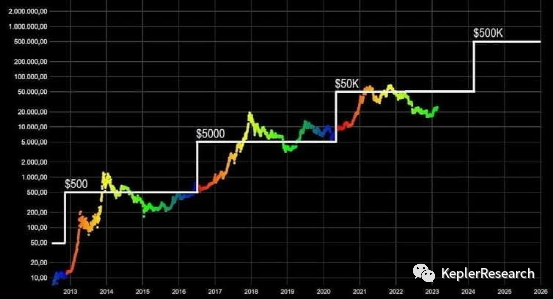1. Bear Market Downturn
The cryptocurrency market has entered a prolonged bearish phase for several months. Despite some bullish trends at the beginning of 2023, most leading cryptocurrencies subsequently experienced a bearish downturn, leading to a significant decrease in their market value.
Furthermore, the sustained bear market can be attributed to a series of factors, including macroeconomic uncertainty, rising interest rates, and geopolitical tensions.
Impact of the Bear Market
Decreased trading volume: As investors become more cautious, trading volume has decreased, leading to reduced market liquidity.
Overall market pessimism: Bearish sentiment has led to widespread investor pessimism, posing challenges for the recovery of cryptocurrency prices.
Elimination of weaker projects: With investors becoming more discerning, the bear market may lead to the failure of weaker cryptocurrency projects and scams.

2. FTX Collapse
In November 2022, the sudden collapse of the FTX cryptocurrency exchange caused a ripple effect throughout the industry, drawing increased attention to the inherent risks of centralized exchanges. Additionally, it raised concerns about regulatory oversight within the cryptocurrency ecosystem.
Impact of the FTX Collapse
Erosion of investor confidence: The collapse weakened investor confidence in centralized exchanges, potentially leading to a shift towards decentralized exchanges.
Calls for enhanced regulation: Regulatory agencies may strengthen scrutiny of cryptocurrency exchanges and impose stricter requirements for licensing and operations.
Demand for increased transparency: Investors are demanding exchanges to enhance transparency, including regular audits and clear communication about risks and security measures.
Following FTX, companies such as Genesis, Terraform Labs, Celsius Network, and BlockFi have also filed for bankruptcy. The aftermath of this event continues to impact the market, prompting investors to closely monitor developments in the cryptocurrency market.

3. Rise of Layer 2 Contracts
Layer 2 scaling solutions, operating as overlays on existing blockchain infrastructures such as Ethereum, are gaining significant traction. These solutions, including zero-knowledge and optimistic rollups, are expected to address ongoing industry challenges.
Here are some of the most significant advantages of Layer 2 smart contracts.
Scalability: Layer 2 solutions can process smart contracts faster and more efficiently, addressing congestion and high fees on the underlying blockchain.
Lower transaction fees: By offloading transactions from the main chain, Layer 2 solutions significantly reduce user transaction fees.
Interoperability: Some Layer 2 solutions aim to bridge different blockchains, enabling seamless communication and asset transfers across multiple networks.
4. Increasing Environmental Impact of Cryptocurrencies
The energy-intensive nature of cryptocurrency mining, particularly evident in proof-of-work blockchains like Bitcoin, has raised growing concerns about its environmental footprint.
As the cryptocurrency industry continues to expand, the industry's energy consumption and carbon emissions have garnered significant attention. Consequently, there is a growing call for adopting more environmentally friendly mining methods and widespread implementation of proof-of-stake consensus mechanisms. All these factors combined make it a rising trend for cryptocurrencies in 2023-2024.
5. Strong Momentum for Central Bank Digital Currencies (CBDC)
CBDCs are digital versions of national currencies issued and controlled by central banks. As governments explore their potential to enhance financial inclusion, efficiency, and monetary policy control, they are increasingly gaining attention globally.
Key Advantages of CBDCs
Financial inclusion: CBDCs can reach populations without bank accounts and with limited access to banking services, enabling their participation in the digital economy.
Efficiency: CBDCs can streamline cross-border payments and reduce transaction costs, thereby enhancing the efficiency of the financial system.
Monetary policy control: CBDCs provide central banks with greater control over monetary policy and the ability to implement targeted intervention measures.
Some countries, including China, Sweden, and the Bahamas, have already initiated CBDC pilot programs, while others are actively researching and developing their own digital currency solutions.

6. Unleashing the Potential of Ethereum 2.0
Ethereum 2.0 is a significant upgrade to the Ethereum blockchain, gradually transitioning from the energy-intensive proof-of-work to a more sustainable proof-of-stake (PoS) consensus mechanism.
This shift is expected to alleviate scalability issues, reduce transaction fees, and enhance the overall efficiency of the Ethereum network. As Ethereum 2.0 continues to evolve, it is poised to open new horizons for decentralized applications (dApps). Additionally, it will solidify Ethereum's position as a leading blockchain platform.

7. Role of Cryptocurrencies in Geopolitical Conflicts
Cryptocurrencies are increasingly being used as tools in geopolitical conflicts and wars. Governments around the world are exploring the use of cryptocurrencies for various purposes, making it a significant trend for cryptocurrencies in 2023-2024.
We have mentioned several ways in which cryptocurrencies are being used as tools of war on a global scale.
Sanctions evasion: Countries facing economic sanctions often turn to cryptocurrencies to evade restrictions and access funds.
Covert operations: Intelligence agencies frequently use cryptocurrencies to fund covert operations or support proxy groups.
Financial influence: Governments also utilize held cryptocurrencies to manipulate markets or exert pressure on other countries.
The ongoing Russia-Ukraine conflict highlights the potential of cryptocurrencies to play a significant role in contemporary warfare and diplomacy.
8. Applications for Cryptocurrency Exchange-Traded Funds (ETFs)
In June 2023, BlackRock applied for a spot Bitcoin ETF, and various cryptocurrencies have followed suit. Cryptocurrency ETFs will provide regulated and user-friendly avenues for investors to access digital assets. Additionally, this eliminates the need for direct asset management.
As of October 2023, there are reports that the first Bitcoin ETF may potentially be approved in early 2024. This paves the way for potential new avenues for institutional and retail investors to participate in the cryptocurrency market, ushering in a new era of accessibility and legitimacy.
9. Global Cryptocurrency Regulation
Governments worldwide are increasingly focusing on regulating cryptocurrencies to address issues related to consumer protection, financial stability, and illicit activities.
Regulatory Approaches
Protective measures: Some countries have implemented regulations to protect consumers from fraud, scams, and market manipulation.
Anti-money laundering (AML) and know your customer (KYC): Additionally, regulations are being implemented to prevent the use of cryptocurrencies for money laundering and illicit activities.
Taxation: Governments are also developing frameworks for taxing cryptocurrency transactions and gains.
Furthermore, establishing clear and consistent regulatory frameworks is crucial for the long-term stability and adoption of cryptocurrencies. While some regulations may initially appear restrictive, they can provide legitimacy and create a safer environment for investors and users.
10. Bitcoin Halving
Bitcoin halving is a key event in the Bitcoin ecosystem, occurring approximately every four years. It involves halving the block reward for mining new bitcoins. Additionally, this event has historically had a significant impact on the price of Bitcoin and its overall market dynamics.
The halving will reduce the profitability of mining, as miners receive fewer bitcoins for their efforts. Additionally, this may decrease mining activity, potentially impacting the security of the network and transaction processing speed.
The next Bitcoin halving is expected to occur in 2024. Furthermore, many analysts believe that this could lead to another bull market for Bitcoin, as the reduction in supply and increased demand may drive up prices. However, the overall impact will depend on various factors, including market sentiment, adoption rates, and regulatory developments.

In conclusion, the cryptocurrency trends of 2023-2024 are expected to be both challenging and exciting. From the impact of the bear market to the increasing adoption of cryptocurrencies in the retail industry, from the increasingly stringent scrutiny by regulatory agencies to the environmental impact of cryptocurrency mining, each trend will shape the future of the cryptocurrency world. Finally, it is crucial to stay informed, adaptable, and prepared for what lies ahead as we move forward.
Note: All content represents the author's personal views and is not investment advice, nor should it be interpreted in any way as tax, accounting, legal, business, financial, or regulatory advice. Before making any investment decisions, you should seek independent legal and financial advice, including advice on tax consequences.
For more content, follow: KeplerResearch on Twitter @kepler008

免责声明:本文章仅代表作者个人观点,不代表本平台的立场和观点。本文章仅供信息分享,不构成对任何人的任何投资建议。用户与作者之间的任何争议,与本平台无关。如网页中刊载的文章或图片涉及侵权,请提供相关的权利证明和身份证明发送邮件到support@aicoin.com,本平台相关工作人员将会进行核查。




